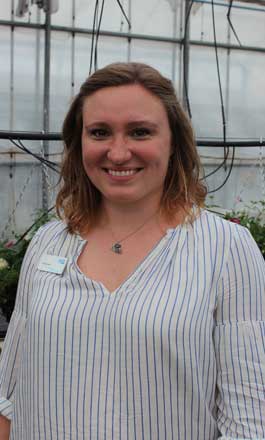With this summer’s temperatures so far being as hot as Hades, growers have no doubt been turning on their nursery’s taps more frequently. But as they water their thirsty young plants – and with the current review of water abstraction licences bubbling away in the background – they are perhaps reminded of the fact that good old “Adam’s ale” is fast-becoming a precious resource.
As Georgina Key, AHDB Horticulture’s resource management scientist (protected ornamentals/bulbs and outdoor flowers/hardy nursery stock panel manager) points out: “Across Europe, horticulture is suffering from an increasing scarcity of water. And the intensity of cultivation is making the quality of water worse. It’s not just in [countries like] Italy and Spain – it’s happening in the UK as well. I know some growers in Kent who have had water restrictions placed on them every June for the last five years. So, it’s really beginning to bite.”

Georgina Key, AHDB Horticulture Resource Management Scientist
But thank heavens above, making the most out of their water by optimising their fertigation practices need not be a Herculanean task for growers. This is because experts from 23 organisations and ten countries have jointly published The Fertigation Bible – a free, downloadable, 800-page publication from the EU-funded FERTINNOWA project.
Georgina says: “There are solutions out there, there’s technology that you can use, but it’s not easily accessible. That is why FERTINNOWA was put together.”
The ten countries helping to spread the good news include the UK, Poland, Germany, Netherlands, Belgium, France, Spain, Italy, Slovenia and South Africa – which, says Georgina, “has real water problems and good technology that we can take advantage of.”
Based on the needs that growers are currently facing, this “sacred scripture” is split into different sections, including:
- Provision of Water,
- Optimising Water Quality,
- Fertigation Equipment,
- Fertigation Management, and
- Reducing Costs and Emissions
Interestingly, the main point to come out of this work is that most growers simply want to “do the relatively low-tech stuff better,” reveals Georgina. With this in mind, each section gives growers both some basic, handy tips as well as inspiring information on the latest technologies. For instance, Provision of Water helpfully informs growers ways in which they can minimise their water loss by simply lining their ponds or small reservoirs. But on the other end of the scale, The Fertigation Bible lists details of the state-of-the-art Dutch Klimrek water buffer system. Georgina explains: “This is very popular in The Netherlands and I am sure that it will come over here before we realise. They build the reservoir underneath the glasshouse, the glasshouse floor floats on top and, if you have a rainfall event, it fills the top compartment with rainwater so you have this lovely, contained, algae-free storage for rainwater. And then as you use the rainwater the floor drops slightly and that triggers the lower compartment to fill with ditch, borehole, or mains water etc.. so that you always have an available water source.”
Arguably, The Fertigation Bible could prove to be a blessing for growers over the coming seasons. It also perhaps reminds us all that we can all learn from our fellow wise men across the pond.
To find out more about ICL's fertigation products
